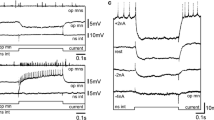Summary
Single unit electrophysiological recordings were obtained from efferent fibres in the statocyst nerves ofOctopus vulgaris. A preparation comprising the CNS and a single statocyst was employed. 42% of the efferents displayed a level of resting activity; transient changes in this activity occurred at irregular intervals.
The responses of the efferent units were examined during sinusoidal oscillations of the statocyst at stimulus frequencies between 0.01–1 Hz, and amplitudes up to 35°. 84% of the units showed activity synchronised with the imposed oscillations; the time taken to establish this response varied for different units (Fig. 1).
The lowest stimulus frequency at which a unit could be entrained varied for different units, with those units with a resting level of activity having the lowest thresholds. The peak firing frequency of the efferents was found to increase with increasing stimulus frequency or amplitude (Fig. 3). However, the change in firing frequency was much smaller than that reported for the statocyst afferents to similar stimuli.
The efferent units of the posterior crista nerve were found to respond to clockwise or anticlockwise rotations (Fig. 4), with the individual units having unipolar responses. The phase response of the units changed little with increasing stimulus amplitude but an increase in phase lag occurred with an increase in the stimulus frequency (Fig. 5). The form of this relationship (Fig. 6) was similar to that reported for the statocyst crista afferents.
The principal source of the input to the efferents in these experiments was shown to be afferents from the contralateral statocyst. These results are discussed and compared with data from the vertebrate semicircular canal system.
Similar content being viewed by others
References
Blanks RHI, Precht W (1976) Functional characterization of primary vestibular afferents in the frog. Exp Brain Res 25:369–390
Budelmann BU (1977) Structure and function of the angular acceleration receptor systems in the statocysts of cephalopods. Symp Zool Soc Lond 38:309–324
Budelmann BU, Thies G (1977) Secondary sensory cells in the gravity receptor system of the statocyst ofOctopus vulgaris. Cell Tissue Res 182:93–98
Budelmann BU, Wolff HG (1973) Gravity responses from angular acceleration receptors inOctopus vulgaris. J Comp Physiol 85:283–290
Budelmann BU, Young JZ (1984) The statocyst-oculomotor system ofOctopus vulgaris: Extraocular eye muscles, eye muscle nerves, statocyst nerves and the oculomotor centre in the central nervous system. Philos Trans R Soc Lond B 306:159–189
Gleisner L, Henriksson NG (1964) Efferent and afferent activity pattern in the vestibular nerve of the frog. Acta Otolaryngol [Suppl] (Stockh) 192:90–103
Goldberg JM, Fernandez C (1975) Vestibular mechanisms. Annu Rev Physiol 37:129–162
Goldberg JM, Fernandez C (1980) Efferent vestibular system in the squirrel monkey: anatomical location and influence on afferent activity. J Neurophysiol 43:986–1025
Hartmann R, Klinke R (1980) Efferent activity in the goldfish vestibular nerve and its influence on afferent activity. Pflügers Arch 388:123–128
Klinke R, Galley N (1974) Efferent innervation of vestibular and auditory receptors. Physiol Rev 54:316–357
Laverack MS (1980) Electrophysiology of the isolated central nervous system of the northern octopusEledone cirrhosa. Mar Behav Physiol 7:155–169
Maturana HR, Sperling S (1963) Unidirectional response to angular acceleration recorded from the middle crista nerve in the statocyst ofOctopus vulgaris. Nature 197:815–816
Messenger JB (1967) The effect on locomotion of lesions to the visuo-motor system inOctopus. Proc R Soc Lond B 167:252–281
Precht W (1974) Physiological aspects of the efferent vestibular system. In: Kornhuber HH (ed) Vestibular system, part 1 (Handbook of sensory physiology, vol VI/1). Springer, Berlin Heidelberg New York, pp 221–238
Precht W, Llinás R, Clarke M (1971) Physiological responses of frog vestibular fibres to horizontal angular rotation. Exp Brain Res 13:378–407
Rossi ML, Prigioni I, Valli P, Casella C (1980) Activation of the efferent system in the isolated frog labyrinth: Effects on the afferent EPSPs and spike discharge recorded from single fibres of the posterior nerve. Brain Res 185:125–137
Schmidt CL, Wist ER, Dichgans J (1971) Efferent frequency modulation in the vestibular nerve of goldfish correlated with saccadic eye movements. Exp Brain Res 15:1–14
Schmidt RS (1963) Frog labyrinthine efferent impulses. Acta Otolaryngol [Stockh] 56:51–64
Williamson R (1985) Efferent influences on the afferent activity from theOctopus angular acceleration receptor system. J Exp Biol (in press)
Williamson R, Budelmann BU (1985a) The responses of theOctopus angular acceleration receptor system to sinusoidal stimulation. J Comp Physiol A 156:403–412
Williamson R, Budelmann BU (1985b) An angular acceleration receptor system of dual sensitivity in the statocyst ofOctopus. Experientia 41:1321–1323
Wilson VJ, Jones GM (1979) Mammalian vestibular physiology. Plenum, New York London
Young JZ (1960) The statocysts ofOctopus vulgaris. Proc R Soc Lond B 152:3–29
Young JZ (1971) The anatomy of the nervous system ofOctopus vulgaris. Oxford, Clarendon Press
Author information
Authors and Affiliations
Rights and permissions
About this article
Cite this article
Williamson, R. Efferent activity in theOctopus statocyst nerves. J. Comp. Physiol. 158, 125–132 (1986). https://doi.org/10.1007/BF00614526
Accepted:
Issue Date:
DOI: https://doi.org/10.1007/BF00614526



